Performance Analysis of a Nine-Phase Squirrel Cage Induction Motor under Faulty Conditions †
Abstract
1. Introduction
2. Background on MOSFET Switch and Stator Winding Faults
2.1. A MOSFET Disconnected Circuit
2.2. MOSFET Short-Circuit Defectiveness
2.3. Stator Winding Faults
3. Experimental Measurements
4. Measured Results and Discussion
4.1. Healthy Operation
4.2. Faulty Operation with Phase A Shorted and Open by Fast Active Fuse
4.3. Operation with Two Adjacent Open-Phase Faults
4.4. Operation with Two Non-Adjacent Open-Phase Faults
5. Conclusions
Author Contributions
Funding
Institutional Review Board Statement
Informed Consent Statement
Data Availability Statement
Conflicts of Interest
References
- Arahal, M.R.; Duran, M.J.; Barrero, F.; Toral, S. Analysis of variable third harmonic injection for five-phase IM. In Proceedings of the European Control Conference (ECC), Budapest, Hungary, 23–26 August 2009; pp. 4350–4355. [Google Scholar]
- Bastos, R.R.; Valle, R.M.; Nau, S.L.; Filho, B.J.C. Modelling and analysis of a nine-phase induction motor with third harmonic current injection. In Proceedings of the 9th International Conference on Power Electronics and ECCE Asia (ICPE-ECCE Asia), Seoul, Republic of Korea, 1–5 June 2015; pp. 688–694. [Google Scholar]
- Zabaleta, M. Permanent Magnet Multi-Phase Machine Modeling and Control for Mv Wind Energy Applications. Doctoral Thesis, Liverpool John Moores University, Liverpool, UK, 2018. [Google Scholar]
- Jung, E.; Yoo, H.; Sul, S.-K.; Choi, H.-S.; Choi, Y.-Y. Nine-phase Permanent Magnet motor drive system for ultra-high-speed elevator. In Proceedings of the IEEE Energy Conversion Congress and Exposition, San Jose, CA, USA, 20–24 September 2009; pp. 1841–1846. [Google Scholar]
- Ertugrul, N.; Soong, W.; Dostal, G.; Saxon, D. Fault-tolerant motor drive system with redundancy for critical applications. In Proceedings of the IEEE Annual Power Electronics Specialists Conference, Cairns, QLD, Australia, 23–27 June 2002; Volume 3, pp. 1457–1462. [Google Scholar]
- Wang, S.; Zhang, X.; Xiong, G.; Wang, J.; Zhang, Z.; Wang, X. A Half-bridge Strategy Based Fault-tolerant Control for BLDCM under Open Circuit Fault. In Proceedings of the 15th IEEE Conference on Industrial Electronics and Applications (ICIEA), Kristiansand, Norway, 9–13 November 2020; pp. 1750–1755. [Google Scholar]
- Vasile, I.; Tudor, E.; Popescu, M.; Dumitru, C.; Popovici, L.; Sburlan, I.C. Electric Drives with Multi-phase Motors as a Better Solution for Traction Systems. In Proceedings of the 11th International Symposium on Advanced Topics in Electrical Engineering (ATEE), Bucharest, Romania, 28–30 March 2019; pp. 1–5. [Google Scholar]
- Yang, S.; Bryant, A.T.; Mawby, P.; Xiang, D.; Ran, L.; Tavner, P.J. An Industry-Based Survey of Reliability in Power Electronic Converters. IEEE Trans. Ind. Appl. 2011, 47, 1441–1451. [Google Scholar] [CrossRef]
- Liao, X.; Shen, Q.; Hu, Y.; Yang, C.; Chen, X.; Li, H. Fault protection for a SiC MOSFET based on gate voltage subjected to short circuit type II. Microelectron. Reliab. 2020, 107, 113624. [Google Scholar] [CrossRef]
- Thomson, W.T.; Fenger, M. Current signature analysis to detect induction motor faults. IEEE Ind. Appl. Mag. 2001, 7, 26–34. [Google Scholar] [CrossRef]
- Duran, M.J.; Barrero, F. Recent Advances in the Design, Modeling, and Control of Multi-phase Machines—Part II. IEEE Trans. Ind. Electron. 2016, 63, 459–468. [Google Scholar] [CrossRef]
- Ruba, M.; Fodorean, D. Analysis of Fault-Tolerant Multiphase Power Converter for a Nine-Phase Permanent Magnet Synchronous Machine. IEEE Tran. Ind. Appl. 2012, 48, 2092–2101. [Google Scholar] [CrossRef]
- Pan, Z.; Ikaheimo, J. Nine-phase variable speed drive system with reduced switching PWM. In Proceedings of the 2014 International Conference on Electrical Machines (ICEM), Berlin, Germany, 2–5 September 2014; pp. 823–828. [Google Scholar]
- Kumar, D.; Davari, P.; Zare, F.; Blaabjerg, F. Analysis of three-phase rectifier systems with controlled DC-link current under unbalanced grids. In Proceedings of the IEEE Applied Power Electronics Conference and Exposition (APEC), Tampa, FL, USA, 26–30 March 2017; pp. 2179–2186. [Google Scholar]
- Guzman, H.; Barrero, F.; Duran, M.J. IGBT-gating failure effect on a fault-tolerant predictive current-controlled five-phase induction motor drive. IEEE Tran. Ind. Electron. 2015, 62, 15–20. [Google Scholar] [CrossRef]
- De Souza, T.S.; Bastos, R.R.; Filho, B.J.C. Modeling and Control of a Nine-Phase Induction Machine With Open Phases. IEEE Trans. Ind. Appl. 2018, 54, 6576–6585. [Google Scholar] [CrossRef]
- Pan, Z.; Ikaheimo, J. Control optimization of nine-phase variable speed drive. In Proceedings of the IEEE International Electric Machines and Drives Conference (IEMDC), Coeur d’Alene, ID, USA, 10–13 May 2015; pp. 910–915. [Google Scholar]
- Ajaz, M.; Anwar, A.B.; Tanwar, A.K.; Vashisht, B. Simulation, and mathematical modeling of nine-phase Induction Motor Drive. In Proceedings of the 12th IEEE International Conference Electronics, Energy, Environment, Communication, Computer, Control (INDICON), New Delhi, India, 17–20 December 2015; pp. 1–6. [Google Scholar]
- Jaya, A.; Soebagio, S.; Purnomo, M.H. Nine-phase induction motor dynamic model based on 3 × 9 transformation matrix. Telkomnika 2013, 11, 265–276. [Google Scholar] [CrossRef][Green Version]
- De Souza, T.S.; Bastos, R.R.; Filho, B.J.C. Fault analysis in an inverter-Fed Nine-Phase induction machine. In Proceedings of the IEEE Energy Conversion Congress and Exposition (ECCE), Cincinnati, OH, USA, 1–5 October 2017; pp. 371–378. [Google Scholar]
- Ruba, M.; Surdu, F.; Szabo, L. Study of a Nine-Phase Fault-Tolerant Permanent Magnet Starter-Alternator. J. Comput. Sci. Control. Syst. 2011, 4, 149–154. [Google Scholar]
- Onsal, M.; Demir, Y.; Aydin, M. A New Nine-Phase Permanent Magnet Synchronous Motor with Consequent Pole Rotor for High-Power Traction Applications. IEEE Trans. Magnet. 2017, 53, 2–7. [Google Scholar] [CrossRef]
- Sowmiya, M.; Renukadevi, G.; Rajambal, K. IFOC of a Nine Phase Induction Motor Drive. Int. J. Eng. Sc. Innov. Tech. 2013, 2, 72–78. [Google Scholar]
- Sui, Y.; Liu, J.; Yin, Z.; Zheng, P.; Cheng, L.; Tang, D. Short-circuit fault detection for a five-phase 30-slot/32-pole permanent-magnet synchronous machine. In Proceedings of the 21st International Conference on Electrical Machines and Systems (ICEMS), Jeju, Republic of Korea, 7–10 October 2018; pp. 50–54. [Google Scholar]
- Pavithran, K.N.; Parimelalagan, R.; Krishnamurthy, M.R. Studies on inverter-fed five-phase induction motor drive. IEEE Trans. Ind. Appl. 1988, 3, 224–235. [Google Scholar] [CrossRef]
- Kong, W.; Qu, R.; Huang, J.; Kang, M. Air-gap and yoke flux density optimization for multi-phase induction motor based on novel harmonic current injection method. In Proceedings of the 2016 XXII International Conference on Electrical Machines (ICEM), Lausanne, Switzerland, 4–7 September 2016; pp. 100–106. [Google Scholar]
- Rockhill, A.A.; Lipo, T.A. A generalized transformation methodology for polyphase electric machines and networks. In Proceedings of the IEEE International Electric Machines & Drives Conference (IEMDC), Coeur d’Alene, ID, USA, 10–13 May 2015; pp. 27–34. [Google Scholar]
- Komurgoz, G.; Geitner, G. Application of the unified electric motor Bond Graph model to HB-type and PM-type Vernier machines. In Proceedings of the 42nd Annual Conference of the IEEE Industrial Electronics Society (IECON), Florence, Italy, 23–26 October 2016; pp. 4263–4268. [Google Scholar]
- Ashourloo, M.; Trescases, O. Short-Circuit Fault Diagnosis and Post-Fault Control with Adaptive PLL-Based Synchronization for a Multi-phase Quasi-Square-Wave DC-DC Converter. In Proceedings of the 20th European Conference on Power Electronics and Applications (EPE’18 ECCE Europe), Riga, Latvia, 17–21 September 2018; pp. 1–10. [Google Scholar]
- Boldea, I.; Nasar, S.A. The Induction Machine Handbook; CRC Press: New York, NY, USA, 2002. [Google Scholar]
- Lojek, B. William Schockley: The Will to Think; Springer: Cham, Switzerland, 2022. [Google Scholar]
- Holmes, G.; Lipo, T.A. Frontmatter in Pulse Width Modulation for Power Converters: Principles and Practice; Willey-IEEE Press: Hoboken, NJ, USA, 2003. [Google Scholar]
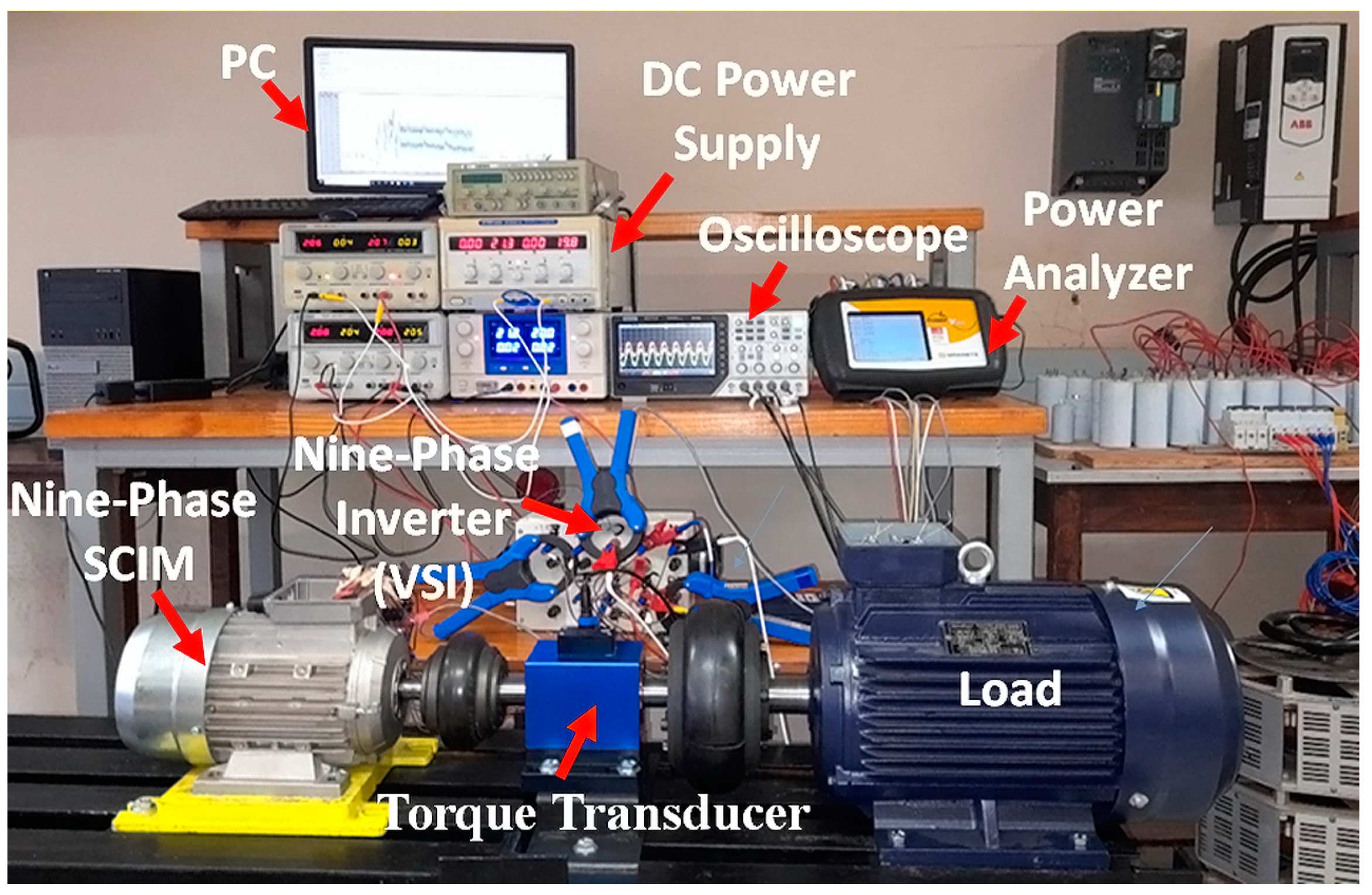

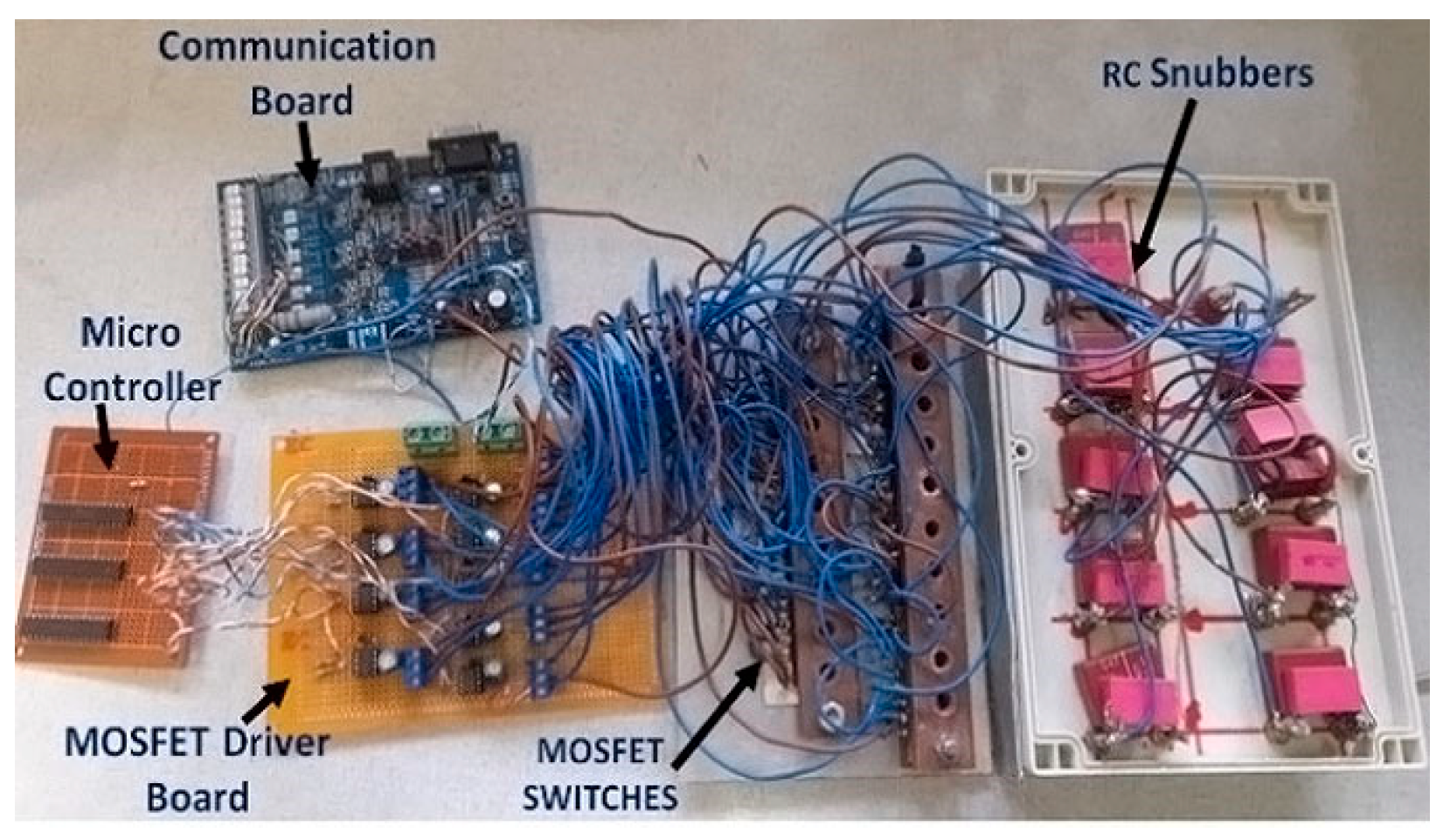



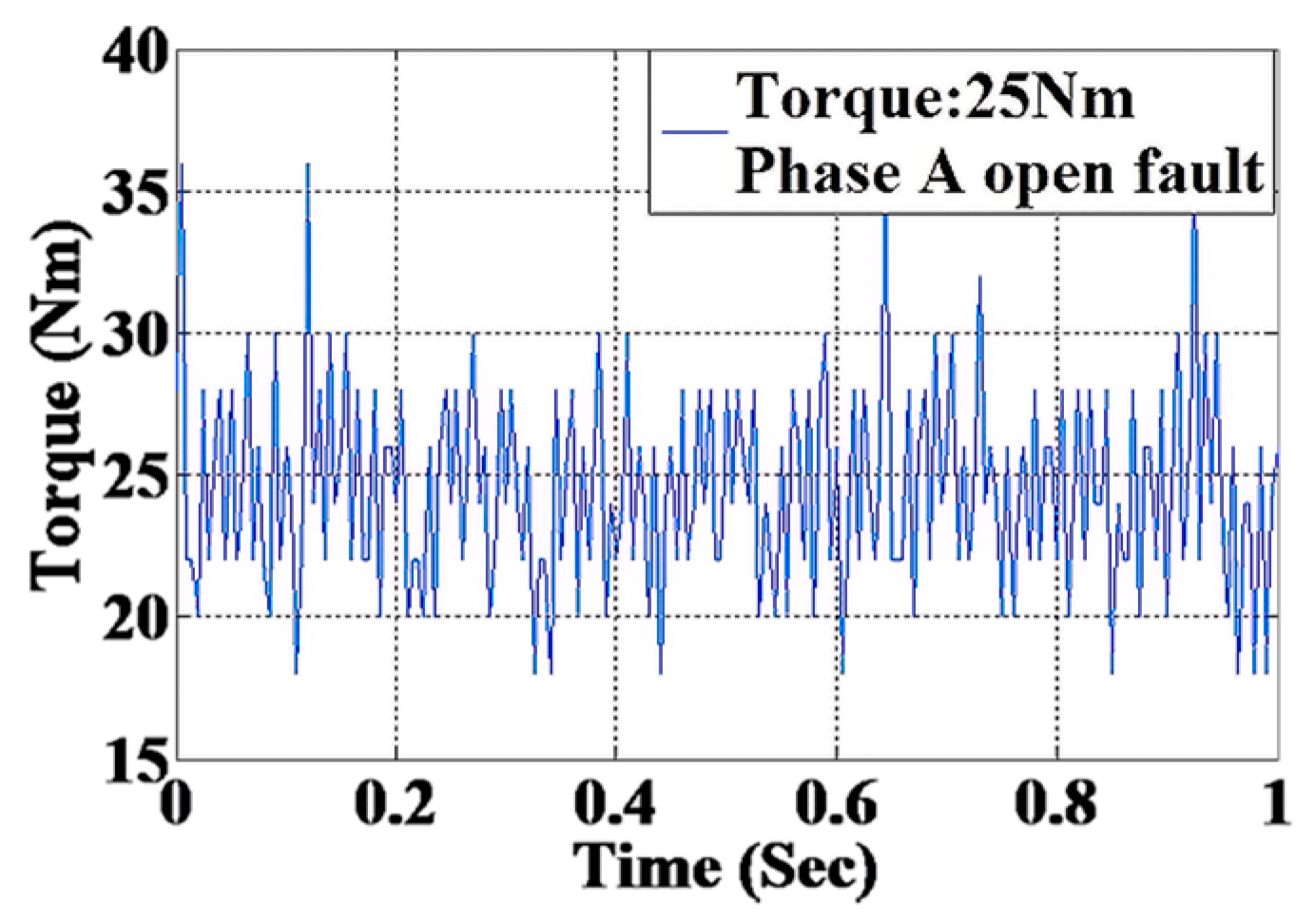
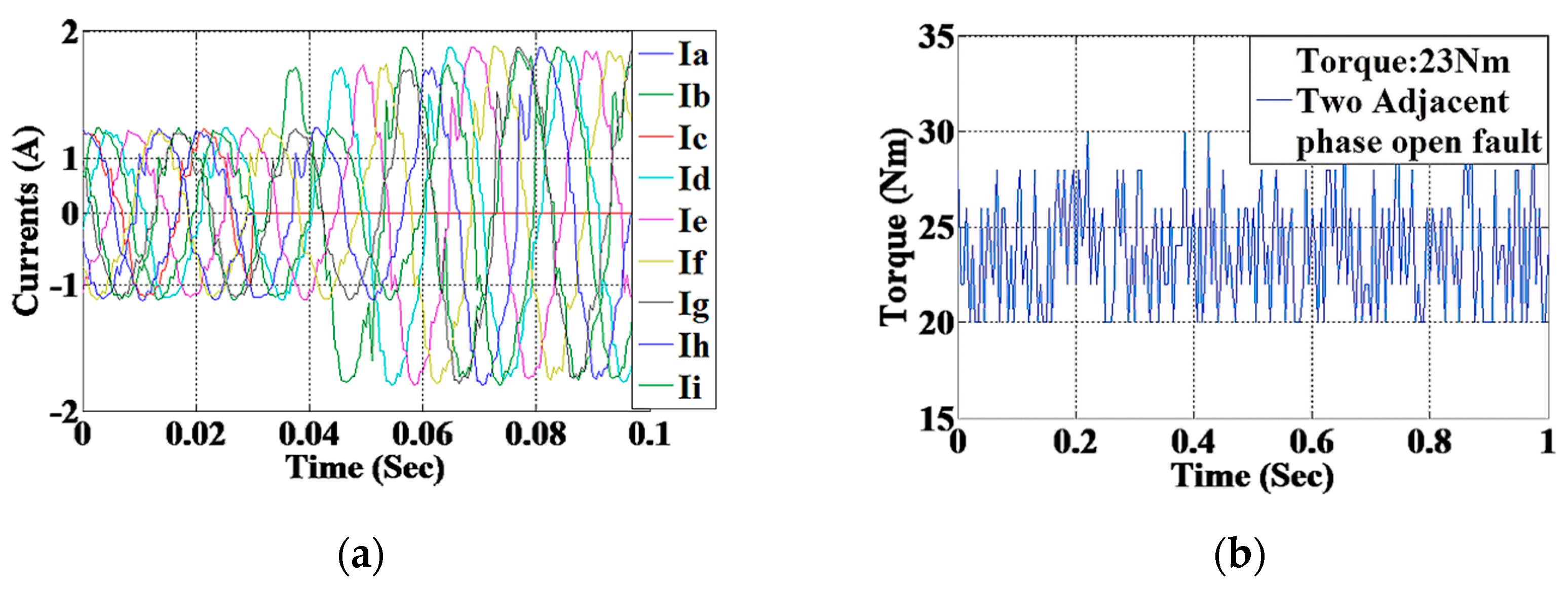
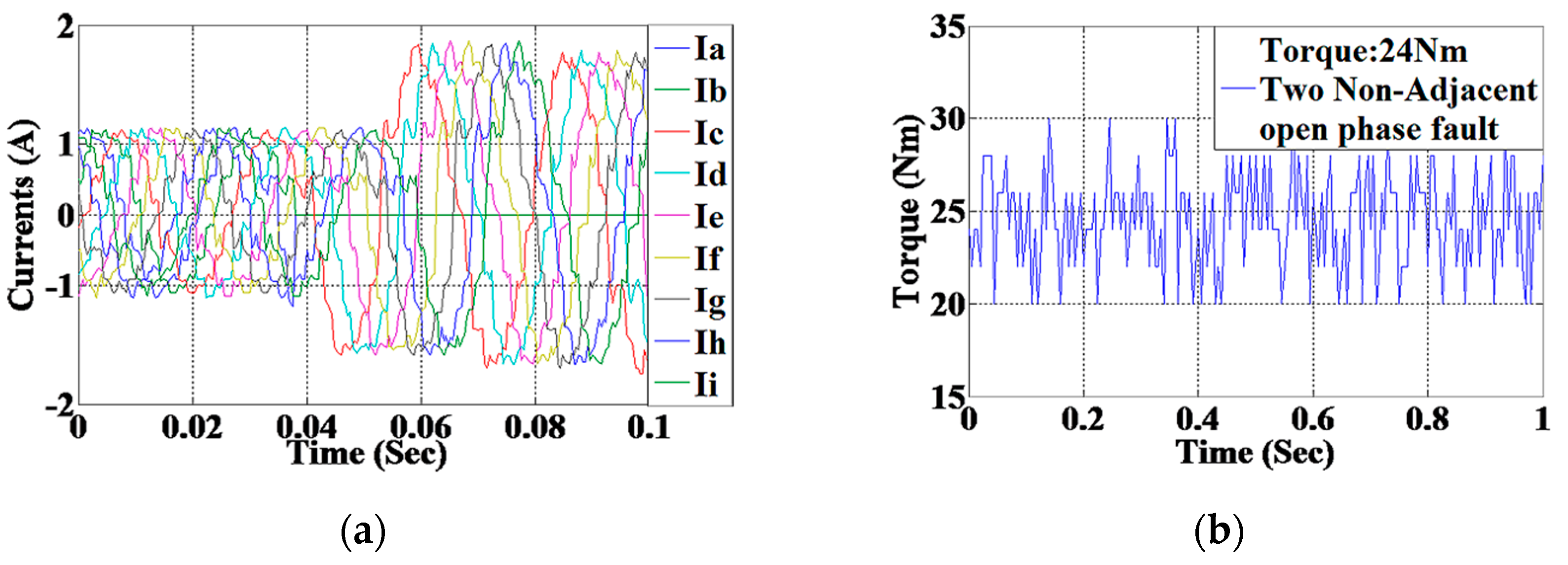
| Description | Values | Unit |
|---|---|---|
| Rated line current | 1.59 | A |
| Base frequency of the motor | 50 | Hz |
| Nominal line voltage | 150 | V |
| Number of phases | 9 | - |
| Rated speed | 1460 | rpm |
| Number of pole pairs | 2 | - |
| PWM switching frequency | 4 | kHz |
| Rated DC bus voltage | 230 | V |
| Stator leakage reactance per phase | 0.567 | Ω |
| Rotor leakage reactance per phase | 0.224 | Ω |
| Stator resistance per phase | 2.805 | Ω |
| Rotor resistance referred to the stator | 2.3 | Ω |
| Number of stator slots | 36 | - |
| Number of rotor bars | 28 | - |
| Number of series conductors per phase | 192 | - |
| Outer radius | 68 | mm |
| Inner radius | 39.85 | mm |
| Core length: stator and rotor | 160 | mm |
| Shaft radius | 10 | mm |
| Length of airgap | 0.35 | mm |
Disclaimer/Publisher’s Note: The statements, opinions and data contained in all publications are solely those of the individual author(s) and contributor(s) and not of MDPI and/or the editor(s). MDPI and/or the editor(s) disclaim responsibility for any injury to people or property resulting from any ideas, methods, instructions or products referred to in the content. |
© 2024 by the authors. Licensee MDPI, Basel, Switzerland. This article is an open access article distributed under the terms and conditions of the Creative Commons Attribution (CC BY) license (https://creativecommons.org/licenses/by/4.0/).
Share and Cite
Maeko, M.G.; Muteba, M. Performance Analysis of a Nine-Phase Squirrel Cage Induction Motor under Faulty Conditions. Eng. Proc. 2024, 60, 14. https://doi.org/10.3390/engproc2024060014
Maeko MG, Muteba M. Performance Analysis of a Nine-Phase Squirrel Cage Induction Motor under Faulty Conditions. Engineering Proceedings. 2024; 60(1):14. https://doi.org/10.3390/engproc2024060014
Chicago/Turabian StyleMaeko, Mpho Glen, and Mbika Muteba. 2024. "Performance Analysis of a Nine-Phase Squirrel Cage Induction Motor under Faulty Conditions" Engineering Proceedings 60, no. 1: 14. https://doi.org/10.3390/engproc2024060014
APA StyleMaeko, M. G., & Muteba, M. (2024). Performance Analysis of a Nine-Phase Squirrel Cage Induction Motor under Faulty Conditions. Engineering Proceedings, 60(1), 14. https://doi.org/10.3390/engproc2024060014






